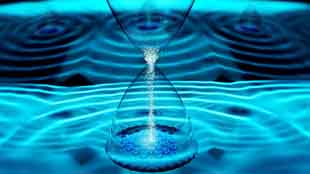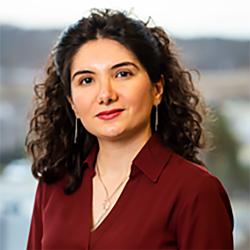Ions Sync Up into World’s First Time Crystal
Researchers forge a new state of matter using atoms and lasers
Consider, for a moment, the humble puddle of water. If you dive down to nearly the scale of molecules, it will be hard to tell one spot in the puddle from any other. You can shift your gaze to the left or right, or tilt your head, and the microscopic bustle will be identical—a situation that physicists call highly symmetric.
 That all changes abruptly when the puddle freezes. In contrast to liquid water, ice is a crystal, and it gains a spontaneous rigid structure as the temperature drops. Freezing fastens neighboring water molecules together in a regular pattern, and a simple tilt of the head now creates a kaleidoscopic change.
That all changes abruptly when the puddle freezes. In contrast to liquid water, ice is a crystal, and it gains a spontaneous rigid structure as the temperature drops. Freezing fastens neighboring water molecules together in a regular pattern, and a simple tilt of the head now creates a kaleidoscopic change.
In 2012, Nobel-prize winning physicist Frank Wilczek, a professor at the Massachusetts Institute of Technology, proposed something that sounds pretty strange. It might be possible, Wilczek argued, to create crystals that are arranged in time instead of space. The suggestion prompted years of false starts and negative results that ruled out some of the most obvious places to look for these newly named time crystals.
Now, five years after the first proposal, a team of researchers led by physicists at the Joint Quantum Institute and the University of Maryland have created the world’s first time crystal using a chain of atomic ions. The result, which finally brings Wilczek’s exotic idea to life, was reported in Nature on March 9.
Much like freezing destroys the symmetry of liquid water, a time crystal disturbs a regularity in time. This is somewhat surprising, says lead author and JQI postdoctoral researcher Jiehang Zhang, since nature usually responds in sync to things that change in time. “The earth rotates around the sun once a year, and the seasons have the same period,” Zhang says. “That’s what you would naturally expect.”
A time crystal doesn’t follow the lead, instead responding with a slower frequency—like a bell struck once a second that rings every other second. The atomic ions in the Maryland experiment, which researchers manipulated using laser pulses, responded exactly half as fast as the sequence of pulses that drove them.
Zhang, JQI Fellow Christopher Monroe and a group of experimentalists at UMD teamed up with a theory group at the University of California, Berkeley to create their time crystal. The Berkeley group, led by physicist Norman Yao, had previously proposed a way to create time crystals in the lab. For a chain of atomic ions, the challenge came down to finding the right sequence of laser pulses, along with assembling the sea of mirrors and lenses that ensured the lasers impinged on the ions in the right way.
To create their time crystal, researchers activated three types of laser-driven behavior in a chain of ten ytterbium ions. First, each ion was bombarded with its own individual laser beam, flipping an internal quantum property called spin by roughly 180 degrees with each pulse. Second, the ions were induced to interact with each other, coupling their internal spins together like two neighboring magnets. Finally, random disorder—essentially noise—was sprinkled onto each ion, a feature known from previous experiments to prevent the spins from jostling and heating up the chain.
Altogether, this sequence twisted around the ions’ spins, and researchers kept track of the orientation of each spin after many repetitions of the sequence. When all three laser-driven behaviors were turned on, the spins of each ion synced up, and they would rhythmically return to their original direction at half the speed of the laser sequence.
But a time crystal is more than mere repetition, and this alone would not be enough to claim the creation of a time crystal, Zhang says. A crystal also needs to be rigid. “If you put a bunch of billiard balls on a pool table separated by exactly 10 centimeters, is that a crystal?” Zhang says. “Not really, because if you shake the table a little bit it will fall apart.”
Zhang and his colleagues demonstrated that their ions had this rigidity by attempting to artificially “melt” the time crystal. By modifying one of the laser pulses—essentially shaking the table—they observed that the rhythm remained stable, up to a point. Past a certain amount of heating, the time crystal dissolved away, just as an ice cube can melt back into a small puddle of water. But with weak shaking, it remained stable, a fact that provided the key evidence that they had created a time crystal.
This rigidity makes time crystals a potential ingredient for clocking complex quantum systems that have inherent defects and are hard to control. They could have applications to future quantum computers, which will also need to be robust. But such applications are still a long way off, especially since the time crystal that Zhang and collaborators produced lasted less than a millisecond.
“This bizarre state of matter results from a complex interplay between many quantum controls at the individual atomic level,” says Monroe. “But time crystals can also emerge in certain solid-state devices, so a general understanding of this phenomenon could help bring such systems into future quantum devices.”
In the same issue of Nature, a group of researchers from Harvard University, also working with Berkeley’s Yao, reported the creation of a time crystal using just such a solid-state system. Instead of ions, they used natural defects found in diamond to set up their crystal.
###
This work was supported by the United States Army Research Office, the Air Force Office of Scientific Research (Award No. FA9550-14-1-0035), the Intelligence Advanced Research Projects Activity, the Intelligence Community Postdoctoral Research Fellowship Program, the National Science Foundation, the Miller Institute for Basic Research in Science, the Simons Investigator Program, and the United States Department of Energy (Award No. DE-AC02-05CH11231). The content of this article does not necessarily reflect the views of these organizations.
The research paper, “Observation of a discrete time crystal,” Jiehang Zhang, Paul Hess, Antonios Kyprianidis, Patrick Becker, Aaron Lee, Jake Smith, Guido Pagano, Ionut-Dragos Potirniche, Andrew Potter, Ashvin Vishwanath, Norman Yao and Christopher Monroe was published March 8, 2017 in the journal Nature.
Media Relations Contact: Chris Cesare, 301-405-0824, ccesare@umd.edu
Joint Quantum Institute
University of Maryland
College Park, MD 20742
www.cmns.umd.edu
@UMDscience
About the College of Computer, Mathematical, and Natural Sciences
The College of Computer, Mathematical, and Natural Sciences at the University of Maryland educates more than 7,000 future scientific leaders in its undergraduate and graduate programs each year. The college's 10 departments and more than a dozen interdisciplinary research centers foster scientific discovery with annual sponsored research funding exceeding $150 million.







